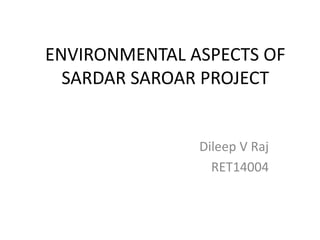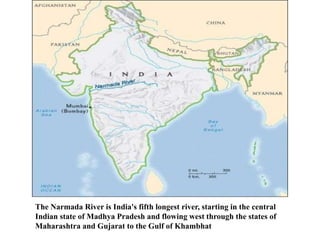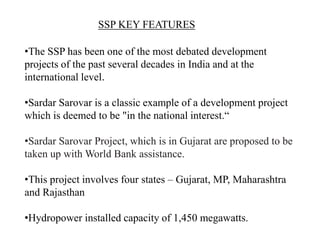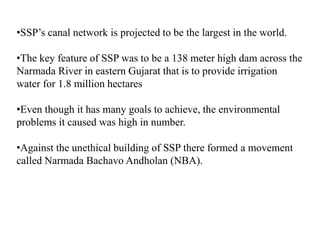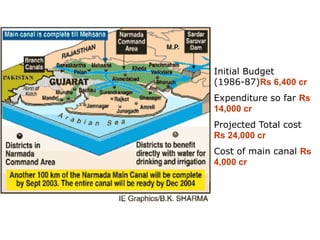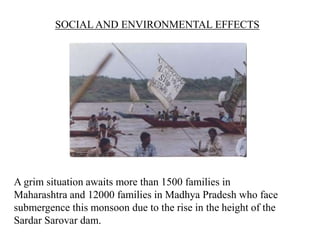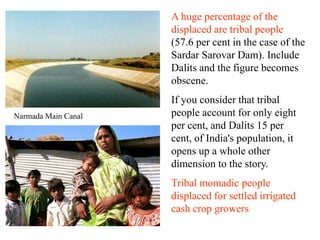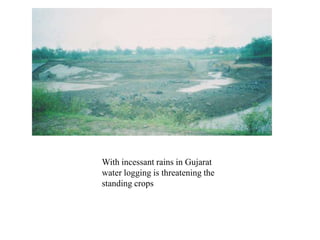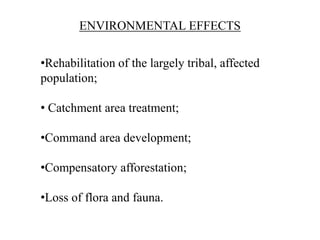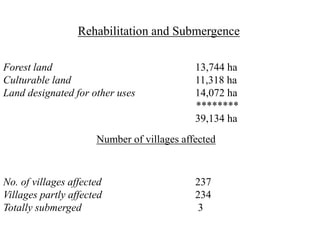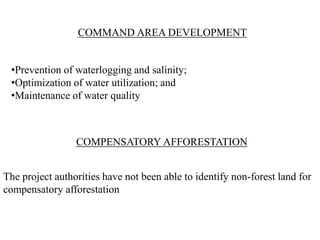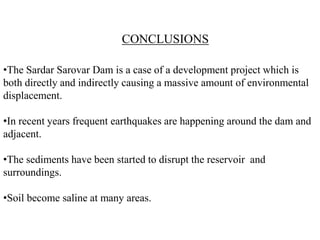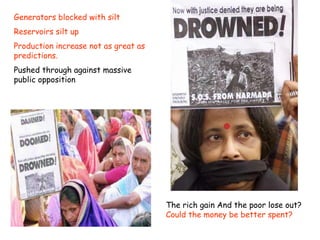Environmental aspects of sardar saroar project
- 1. ENVIRONMENTAL ASPECTS OF SARDAR SAROAR PROJECT Dileep V Raj RET14004
- 2. The Narmada River is India's fifth longest river, starting in the central Indian state of Madhya Pradesh and flowing west through the states of Maharashtra and Gujarat to the Gulf of Khambhat
- 3. The Sardar Sarovar Dam is the second largest project in the Narmada Valley in terms of both total area submerged and the numbers of people displaced
- 4. SSP KEY FEATURES •The SSP has been one of the most debated development projects of the past several decades in India and at the international level. •Sardar Sarovar is a classic example of a development project which is deemed to be "in the national interest.“ •Sardar Sarovar Project, which is in Gujarat are proposed to be taken up with World Bank assistance. •This project involves four states – Gujarat, MP, Maharashtra and Rajasthan •Hydropower installed capacity of 1,450 megawatts.
- 5. •SSP’s canal network is projected to be the largest in the world. •The key feature of SSP was to be a 138 meter high dam across the Narmada River in eastern Gujarat that is to provide irrigation water for 1.8 million hectares •Even though it has many goals to achieve, the environmental problems it caused was high in number. •Against the unethical building of SSP there formed a movement called Narmada Bachavo Andholan (NBA).
- 6. Initial Budget (1986-87)Rs 6,400 cr Expenditure so far Rs 14,000 cr Projected Total cost Rs 24,000 cr Cost of main canal Rs 4,000 cr
- 7. ISSUES RAISED •The SSP is not only a vast project, it is also a project that creates an extensive submergence zone. The reservoir will have an extension upto 240 Km. •Each additional metre of dam construction at this juncture has such important consequences in terms of submergence. •Once completed the Sardar Sarovar Dam Project will submerge approximately 37,000 hectares of land for the reservoir, and approximately 80,000 hectares for the extensive canal works. •It will displace at least 100,000 people who reside in approximately 245 villages. Approximately 140,000 additional farmers will be affected by the canal and irrigation system.
- 8. SOCIAL AND ENVIRONMENTAL EFFECTS A grim situation awaits more than 1500 families in Maharashtra and 12000 families in Madhya Pradesh who face submergence this monsoon due to the rise in the height of the Sardar Sarovar dam.
- 9. Residents of Pendriapada (Guj) look on their destroyed homes and fields Stagnant water increased…. More mosquitoes breeding… Increased levels of malaria…
- 10. Narmada Main Canal A huge percentage of the displaced are tribal people (57.6 per cent in the case of the Sardar Sarovar Dam). Include Dalits and the figure becomes obscene. If you consider that tribal people account for only eight per cent, and Dalits 15 per cent, of India's population, it opens up a whole other dimension to the story. Tribal momadic people displaced for settled irrigated cash crop growers
- 11. With incessant rains in Gujarat water logging is threatening the standing crops
- 12. ENVIRONMENTAL EFFECTS •Rehabilitation of the largely tribal, affected population; • Catchment area treatment; •Command area development; •Compensatory afforestation; •Loss of flora and fauna.
- 13. Good land and vegetation Flooded and Dried
- 14. Near completion of Sardar Sarovar Dam in August 2004, monsoon winds flooded the Narmada, causing it to be clogged with sediment. Floodwater also broke through the canal wall, submerging local villages and engulfing hundreds of homes.
- 15. Rehabilitation and Submergence Forest land 13,744 ha Culturable land 11,318 ha Land designated for other uses 14,072 ha ******** 39,134 ha Number of villages affected No. of villages affected 237 Villages partly affected 234 Totally submerged 3
- 16. COMMAND AREA DEVELOPMENT •Prevention of waterlogging and salinity; •Optimization of water utilization; and •Maintenance of water quality COMPENSATORY AFFORESTATION The project authorities have not been able to identify non-forest land for compensatory afforestation
- 17. CONCLUSIONS •The Sardar Sarovar Dam is a case of a development project which is both directly and indirectly causing a massive amount of environmental displacement. •In recent years frequent earthquakes are happening around the dam and adjacent. •The sediments have been started to disrupt the reservoir and surroundings. •Soil become saline at many areas.
- 18. Generators blocked with silt Reservoirs silt up Production increase not as great as predictions. Pushed through against massive public opposition The rich gain And the poor lose out? Could the money be better spent?
- 19. Its never for a better cause. Its all for some political dealings. Raise Up the voice Narmada Bachavo Andholan

